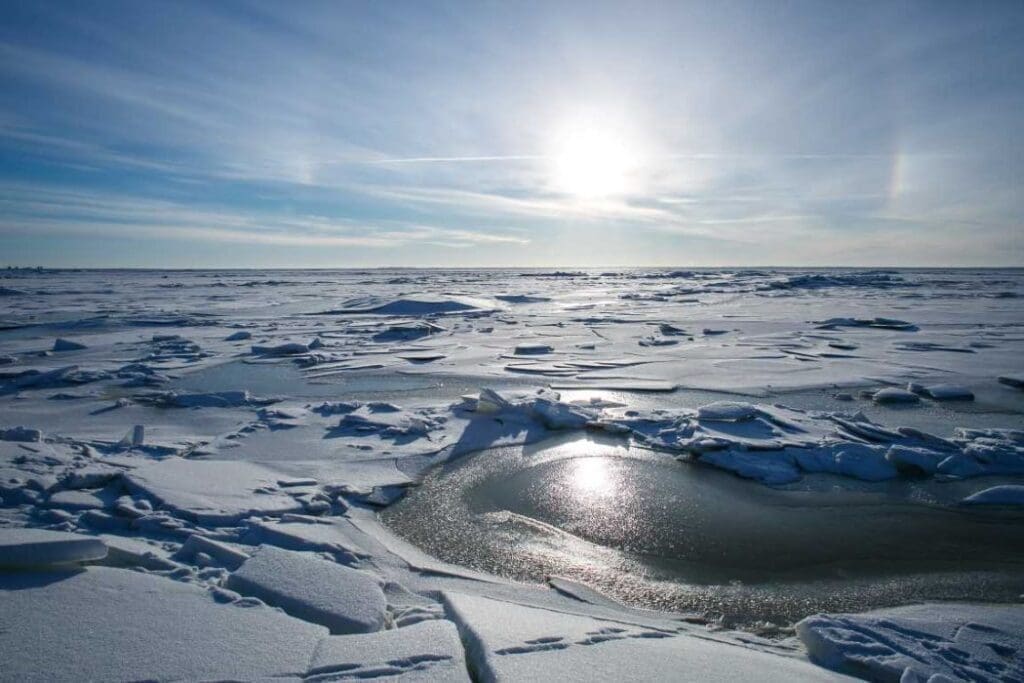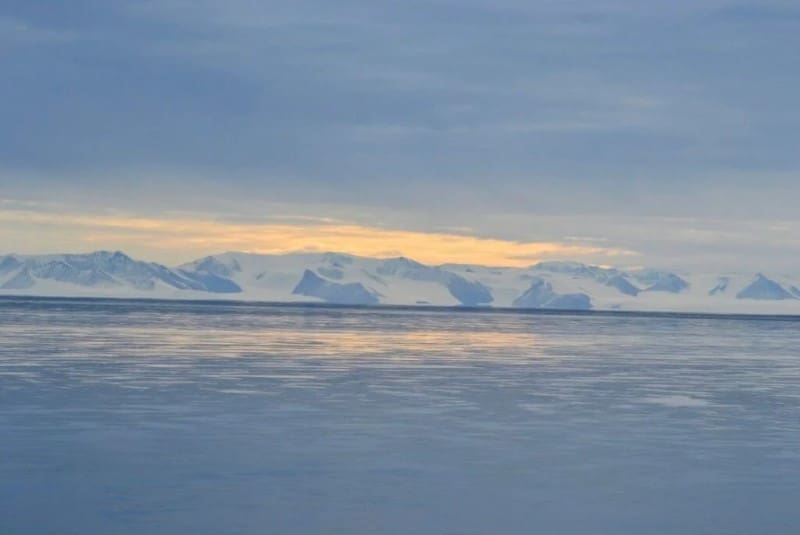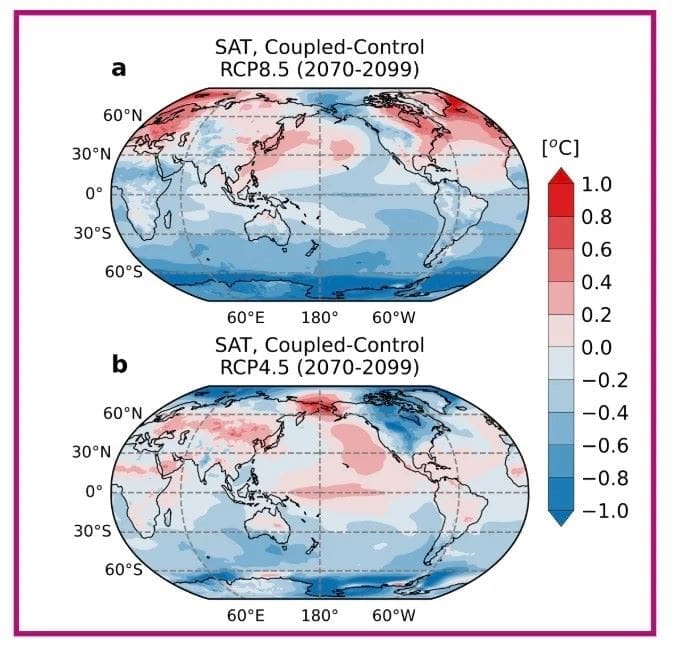Explore the latest insights from top science journals in the Muser Press roundup (November 7, 2025), featuring impactful research on climate change challenges.
In brief:
Climate whiplash effects due to rapidly intensifying El Niño cycles
Using high-resolution climate models (Figure 1), a team of researchers from South Korea, the USA, Germany, and Ireland found that ENSO could intensify rapidly over the coming decades and synchronize with other major climate phenomena, reshaping global temperature and rainfall patterns by the end of the 21st century.
The study projects an abrupt shift within the next 30-40 years from irregular El Niño-La Niña cycles to highly regular oscillations, characterized by amplified sea surface temperature (SST) fluctuations (Figure 2).
“In a warmer world, the tropical Pacific can undergo a type of climate tipping point, switching from stable to unstable oscillatory behavior. This is the first time this type of transition has been identified unequivocally in a complex climate model,” says Prof. Malte F. Stuecker, lead author of the study and Director of the International Pacific Research Center at the University of Hawaiʻi at Mānoa, USA. “Enhanced air-sea coupling in a warming climate, combined with more variable weather in the tropics, leads to a transition in amplitude and regularity,” he adds.

According to the high-resolution computer model simulations analyzed in the study, the stronger and more regular ENSO cycles are also expected to synchronize with other climate phenomena, including the North Atlantic Oscillation (NAO), the Indian Ocean Dipole (IOD), and the Tropical North Atlantic (TNA) mode, similar to how multiple weakly connected pendulums adjust to swinging with the same frequency.
“This synchronization will lead to stronger rainfall fluctuations in regions such as Southern California and the Iberian Peninsula, increasing the risk of hydroclimate ‘whiplash’ effects,” says Prof. Axel Timmermann, corresponding author of the study and Director of the IBS Center for Climate Physics at Pusan National University, South Korea. “The increased regularity of ENSO could improve seasonal climate forecasts; however, the amplified impacts will necessitate enhanced planning and adaptation strategies,” he adds.
The research utilized the Alfred Wegener Institute Climate Model (AWI-CM3), with 31 km horizontal resolution in the atmosphere and 4-25 km in the ocean, to simulate climate responses under a high-emission greenhouse gas scenario. Observational data and simulations from other climate models were also analyzed to validate the findings. “Our simulation results, which some other climate models support, show that ENSO’s future behavior could become more predictable, but its amplified impacts will pose significant challenges for societies worldwide,” says Dr. Sen ZHAO, co-lead author of the study and researcher at the University of Hawaiʻi at Mānoa.

The new study in Nature Communications highlights the potential for anthropogenic climate change to fundamentally alter the characteristics of ENSO, and its interactions with other climate processes, even in regions far away from the equatorial Pacific, such as Europe. “Our findings underscore the need for global preparedness to address intensified climate variability and its cascading effects on ecosystems, agriculture, and water resources,” says Prof. Timmermann.
In the future, the team will explore the underlying global synchronization processes also in other high-resolution climate model simulations, including those with 9 km and 4 km resolution recently conducted at the IBS Center for Climate Physics on the Aleph supercomputer in South Korea.
Journal Reference:
Stuecker, M.F., Zhao, S., Timmermann, A. et al., ‘Global climate mode resonance due to rapidly intensifying El Niño-Southern Oscillation’, Nature Communications 16, 9013 (2025). DOI: 10.1038/s41467-025-64619-0
Article Source:
Press Release/Material by Institute for Basic Science (IBS)
Home advantage? How consumers misjudge the environmental impact of imported food
Peppers from Spain or from Germany? When consumers assess the environmental impact of food, their decision largely depends on its origin. This is shown by a new survey by researchers at the University of Göttingen. According to the survey, domestic products in supermarkets are perceived as particularly environmentally friendly. But this impression can be misleading. The results raise questions about the design of labelling and advertising.
The study has been published in the journal Food Quality and Preference.

The researchers surveyed around 1,000 people in Germany about the environmental impact of peppers, apples and beef from Germany, EU countries and non-EU countries. “The data shows a clear pattern,” explains Dorothea Meyer, lead author and PhD researcher in Marketing for Food and Agricultural Products. “Imported food – especially from non-EU countries – is perceived as significantly more damaging to the environment. However, it can be similar or in fact even more environmentally friendly than local products.”
For example, Spanish peppers from unheated greenhouses often have environmental advantages over German peppers from heated facilities, which consume more energy due to less favourable conditions. “There can be many advantages to choosing regional products. However, environmental friendliness is not always one of them. It is worth taking a closer look here,” says Meyer. International trade is not necessarily harmful to the environment. In particular, the impact of transport is often overestimated.
The study concludes that information about origin should therefore be more precise and disclose the actual impact on the environment. “Information about origin alone is not enough to inform correct decision-making about sustainability,” emphasises Professor Achim Spiller from the same research group. “Instead, information is needed that makes the actual impact clearer, for example through climate or environmental labels.” This could prevent consumers from accidentally choosing foods that are more damaging to the environment.
Journal Reference:
Dorothea Meyer, Achim Spiller, Sarah Iweala, ‘Perceived environmental impact of food: Upgrading of domestic products and downgrading of imported products’, Food Quality and Preferences 136, 105718 (2025). DOI: 10.1016/j.foodqual.2025.105718
Article Source:
Press Release/Material by University of Göttingen
The warming of the Southern Ocean, a consequence of climate change, threatens the viability of 60% of Antarctic ice shelves
An international team led by scientists from Université Grenoble Alpes and CNRS, within the Grenoble Institute of Environmental Geosciences (IGE – CNRS/INRAE/IRD/UGA – Grenoble INP-UGA), has demonstrated in a study published in Nature that 60% of the floating ice shelves surrounding the Antarctic ice sheet could be destined to disappear in the long term.
These ice shelves currently act as a brake on the contribution of the Antarctic ice sheet to global sea level rise. Under high anthropogenic greenhouse gas emissions leading to a global warming of around 12 °C by 2300, the ocean would warm significantly, causing intense melting at the base of the ice shelves. This would ultimately result in their collapse, drastically reducing their effect as a brake and accelerating the pace of sea level rise. In a scenario of substantial emission reductions limiting global warming to 2 °C, 63 out of 64 shelves could still be viable until 2300 or beyond.

Ice shelves – the floating extensions of the Antarctic ice sheet – are its Achilles’ heel: they currently restrain the flow of continental ice into the ocean, but are extremely sensitive to atmospheric and oceanic warming. Their disappearance would dramatically accelerate sea level rise, one of the major challenges of the coming centuries.
Using a novel method that accounts for the full range of climatic and glaciological uncertainties, including poorly understood processes such as ice fracturing and iceberg calving, the scientists estimated the thresholds beyond which certain ice shelves are unlikely to maintain their shape in the long term.
The unprecedented results of this study show that, of the 64 main Antarctic ice shelves, 26 would be
lost by 2150 if greenhouse gas emissions continue to rise in a scenario corresponding to a planetary
climate about 8 °C warmer than the pre-industrial era. Under this same scenario, global warming would
reach around 12 °C by 2300, and thirty-eight ice shelves would then be destined to disappear. The main cause: ocean warming that would melt the shelves from below, pushing them beyond their viability threshold.
The loss of these ice shelves would remove the natural brake that currently holds back vast portions of the Antarctic ice sheet, paving the way for sea level rise of potentially up to 10 metres over the coming centuries.
Conversely, under a scenario of drastic emission reductions keeping global warming below 2 °C above pre-industrial levels, 63 out of 64 shelves could still survive until 2300 or even beyond. This study therefore confirms that today’s decisions on greenhouse gas reductions will directly determine the future of Antarctica – and of global sea level.
Journal Reference:
Burgard, C., Jourdain, N.C., Mosbeux, C. et al., ‘Ocean warming threatens the viability of 60% of Antarctic ice shelves’, Nature 647, 102–108 (2025). DOI: 10.1038/s41586-025-09657-w
Article Source:
Press Release/Material by Institut Pierre-Simon Laplace (IPSL) | CNRS
URI climate scientist contributes to research illustrating future impacts of Antarctic ice sheet melting
Melting of the Antarctic ice sheet due to global warming has long-term, irreversible societal impacts with important implications for people around the world. Spatial patterns of sea level change from ice sheet mass loss vary in cause, and have world-wide impacts.
Despite the importance of understanding global impacts of ice sheet mass loss, imperfect understanding of ice sheet-climate interactions poses challenges for projecting the impacts it has on the world’s future climate and sea levels.
Ambarish Karmalkar, an assistant professor in the University of Rhode Island’s Department of Geosciences, has partnered with lead author Shaina Sadai and colleagues to better simulate ice sheet-climate interactions and their evolution over the next century. The team published their findings in the recent issue of Nature Communications, reporting that sea level and climate projections are significantly different from simulations that lack interactive ice sheets and realistic Antarctic meltwater discharge.
To study the effects of Antarctic ice sheet melting, the team designed an experiment depicting simultaneous interactions between the ice sheet, ocean, and atmosphere. Their results show that while cold Antarctic meltwater will slow human-induced warming, it also causes uneven sea level rise and significant climatic changes worldwide, highlighting the importance of lowering greenhouse gas emissions.

Working in collaboration with other modelers, Sadai set up and ran simulations on a supercomputer and assembled a team of sea level, ocean, and atmosphere experts, including Karmalkar, to analyze the simulation results. “We predict higher regional sea levels for low-lying islands in the Pacific due to melting in Antarctica,” says Karmalkar. “Simulating ice-sheet-climate interactions also indicates higher Northern Hemisphere temperatures and altered precipitation patterns worldwide.”
“Doing this kind of modeling work is challenging but critical to understanding the full impact of global warming on ice sheets, and how the ice sheets, in turn, affect the climate,” says Karmalkar, who is part of URI’s new specialization in water and climate science. He studies changes in atmospheric and oceanic conditions and their impact. A key focus of his research looks at climate trends, variability, and extremes in different parts of the world, with an emphasis on understanding the atmospheric and oceanic drivers of regional climate change. His career has brought him into varied terrain, from studying fire-climate-vegetation dynamics in the eastern U.S. and climate extremes in the Arctic to work on climate projects across the Americas.
Assessing climate and sea level changes
The team’s research predicts that while Antarctic meltwater will dampen temperature rise in the Southern Hemisphere, it can lead to warming in the North Atlantic and surrounding regions, including in eastern North America.
The paper also notes that insufficient global mitigation could lead to large-scale ice sheet mass loss, exposing people and ecosystems around the world to substantial sea level rise. By 2060, over one billion people could be living in low elevation coastal areas, increasing the risk of sea level rise impacts for socially and geographically vulnerable populations. Understanding interactions between ice sheets and the broader climate system are key to constrain future Antarctic ice sheet stability, global climate, and sea level.

The group notes that current pledges submitted by parties to the United Nations Framework Convention on Climate Change (UNFCCC) are insufficient for meeting the Paris Agreement’s long-term temperature goal of limiting global mean surface temperature rise. Robust mitigation will be crucial for preventing Antarctic ice sheet mass loss and resulting sea level rise.
Their modeling experiment predicts a contribution to sea level rise from the East Antarctic Ice Sheet in a very high emissions scenario. This is especially noteworthy because the ice sheet in East Antarctica is enormous but is currently more stable than its counterpart in West Antarctica. The study shows that the Antarctic contribution to sea level rise by 2200 is over 3m (10 feet) in a very high emissions scenario and about 1m (3 feet) in a medium emissions scenario, underscoring the importance of reducing greenhouse gas emissions.
Consistent with prior research, the team found that regions of the world far away from Antarctica will experience higher sea level rise due to gravitational and Earth deformational effects. They predict that regional sea level rise of up to 1.5m (5 feet) will occur in the Pacific and Indian Ocean basins and Caribbean Sea. In other words, the loss of ice sheet mass will drive substantial sea level rise.
Even with a slower rate of warming, any continued increase in sea level poses risks to island and coastal communities, raising wide-ranging issues of intergenerational inequity and injustice as the lead author Sadai has shown in her previous research. Last week’s destruction in the Caribbean caused by Hurricane Melissa shows how storm surge can devastate vulnerable coastal communities.
“Rising sea levels makes these impacts worse, which is why studies like this that quantify the uneven future rise in sea level are absolutely critical,” says Karmalkar.
***
The team’s work was supported by funding from the National Science Foundation and the National Center for Atmospheric Research.
Journal Reference:
Sadai, S., Karmalkar, A.V., Pollard, D. et al., ‘Antarctic meltwater alters future projections of climate and sea level’, Nature Communications 16, 9271 (2025). DOI: 10.1038/s41467-025-64438-3
Article Source:
Press Release/Material by University of Rhode Island
Featured image credit: Gerd Altmann | Pixabay




